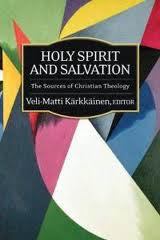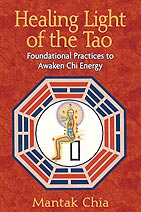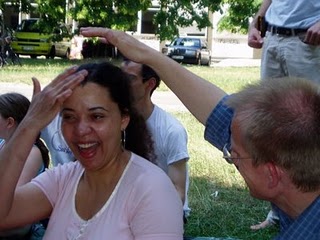![]()
"In the last days, God says, 'I will pour out my Spirit upon all people. Your sons and daughters will prophesy. Your young men will see visions, and your old men will dream dreams.'" Acts 2:17

"In Christianity the Spirit is God permeating God's own creation. According to the creation study in the Hebrew Scriptures, 'a wind [spirit] from God swept over the face of the waters' in the beginning of creation (Gen. 1:2).... Hence, the primary mission of the Spirit has to do with life, creating it, sustaining it and directing it towards its future destiny. The Spirit is the source of life, not only of the present life but of eternal life as well. The Spirit is within creation, but is not conditioned by creation.
Chinese theologians Chang Chun-shen and C. S. Song suggest that this Spirit is what the Chinese would call qi—air, breath and spirit. According to the teachings of Confucianism and Taoism, qi is the material origin of all things; it is at the same time the origin of the life-force and energy moving into action. Or rather it is in itself equipped with life-giving properties and energy for action. The following is a standard expression of qi:
Ch'i [qi] fills the space between heaven and earth. Heaven and earth themselves, all things between heaven and earth, are all constituted by ch'i. Because of ch'i everything between heaven and earth moves, changes, and functions. It itself moves and moves all things. It is the subject of changes and movements and the origin that causes them. Human beings and animal-plant life also consists of ch'i...
The qi must have something to do with the pneuma mention by Jesus. 'The pneuma [air, wind or spirit] blows where it chooses, and you hear the sound of it, but you do not know where it comes from or where it goes' (Jn. 3:8). This is the mystery of pneuma and qi. It is wind as well as spirit. It moves and work like wind, blowing where it wills. This actually is similar to the Old Testament concepts of 'soul' and 'breath,' ...”
Veli-Matti Karkkainen, Holy Spirit and Salvation
Westminster John Knox Press (August 16, 2010) , p. 435

2:17 Last days (eschatais hemerais)-Peter substitutes the expression "last days" here for the expression "After these things" in Joel. The change is explanatory, identifying the time and passage referred to as the "last days.” Jewish interpretation applied this text to the divine work of the last days, with its promise of the pouring out of the Spirit on believers of all kinds, a reminder of promises that came to be seen as part of the new covenant (Jer. 31:31-33; Ezek. 34-37; esp. 36:22-32; Isa. 54:13; Bock, Proclamation, 164-69; Midrash on the Psalms 14 6 [57b]; Rab. Deut. 6:14 [203a]). [eschatos + hemera]
I will pour out my Spirit (ekcheo apo tou pneumatos mou)-The combination of this verb meaning "to pour out" with "The Spirit" summarizes Joel's key promise-that the Spirit would be poured out on "All flesh.” The rest of the citation makes it clear that people of every gender, age, and class are meant. Except for its use in Acts 1:18, where Judas' demise is described, every use of this verb refers to this event or its parallel for Gentiles in Acts 10:45 (Acts 2:17-18, 33). The reappearance of the verb in Acts 2:33 is important, because there Jesus is responsible for the outpouring, an act that makes him responsible for mediating the arrival of the promise of the last days. This act is evidence of Jesus' divine vindication through the resurrection-ascension as Jesus works from the "right hand" of God (see v. 33). [ekcheo]
Shall prophesy (propheteusousin)-Since the tongues are declaring the mighty works of God (Acts 2:11), these utterances are described as prophetic. The idea is repeated in 2:18 for emphasis. The message the audience is hearing comes to them directly from God, revealing what God has done and is doing through recent events. The near association of visions and dreams underscores that what is being revealed through the Spirit is not something one would normally know. It is being revealed through the Spirit's work. The verb is rare in Acts, appearing only here.
Darrell L. Bock, The Bible Knowledge Word Study
Cook Communications Ministries (2002) p. 45

"The idea of chi is not unique to the Chinese. Nearly every culture in the world has a word to express this concept. Dr. John Mann and Larry Short, authors of The Body of Light, count forty-nine cultures around the world that articulate the concept of chi in one form or another.
In Hebrew, the word is ruach, and it appears in the first chapter of the Book of genesis:
In the beginning God created the Heaven and the Earth. The world was without form and void, and darkness was upon the face of the deep; and the ruach [spirit, wind, or breath] of God was moving over the face of the waters. Genesis 1:1-2
Ruach was present at the creation of the universe, even before light. The term means 'breath of God' or 'divine breath.'
In Japanese, the term ki expands the concept of chi to include the Chinese idea of yi, or intention, indicating that our mind or will is a major influence governing the movement of chi, which is very important in meditation and in the martial arts.
In Sanskrit, the word for chi is prana. The Tibetan word is lung. In Lakota Sioux it is known as neyatoneyah. The Bush People of the Kalahari speak of it as num, which means 'boiling energy.' In the Islamic world chi is referred to as barraka. Although many cultures possess an awareness of chi, the Chinese have refined the concept and integrated it into their culture to an unparalleled degree. Chi is a pivotal factor in Chinese medicine, martial arts, meditation, science, painting, calligraphy, architecture, interior design, and poetry.”
Mantak Chia, Healing Light of the Tao
Inner Tradition (Jun 6 2008) pp. 32-33

"One spring afternoon in 1992, a Norwegian friend who was living in my village for a year whilst he completed a Master of Business Administration at Bath University dropped over for coffee. After exchanging the usual set of pleasantries about the weather and a few comments about the local primary school, he introduced a new topic into the conversation. Knowing my interest in new religions, he said, was I aware that some people in the next village were 'giving cool breezes'? I confessed my ignorance and pressed him for details. One, a woman called Jane, he continued, had given him a sort of massage and as a result he had felt a Cool Breeze on the top of his head. 'I really did, you know!' he went on, looking slightly uncomfortable, as he did not quite believe it himself. 'What's it all about?'
This book is my attempt, as a sociologist of religion, to answer the question raised by my friend that day. It is about Sahaja Yoga, the new religious movement (NRM) whose member was responsible for the 'cool breezes' which he felt.”
Judith Coney, Sahaja Yoga (Introduction page)
RoutledgeCurzon; 1 edition (May 24 1999)

"The result, in all three settings [Royal Albert Hall, local meeting or private house], is that many people do feel a Cool Breeze. The coolness which is felt is usually associated with other sensations as well. Typically, the pupils of the eyes can be observed to dilate and the person will feel very relaxed and 'centred.' However, it is notable that, despite the very similar ways in which individuals 'get their realisation'—and even in the same setting—not everybody feels exactly the same thing. Sri Mataji teaches that the vibrations of kundalini can be felt as Cool Breeze on the palm of the hands and above the head. Sometimes breezes, in line with the teachings, are felt on the hands and head specifically. For others, the experience is more generalized:
The experience was extremely timeless, because I felt that it only lasted for about five minutes but somebody came behind me and said 'would you like a cup of tea' and I thought, 'this is silly, what's all this about tea?; But it turned out that it was about three quarters of an hour later. And I felt a strong Cool Breeze. I was actually told; you will probably feel some coolness or some nice feelings inside' but I felt coolness not just in my hands, where I was told it would be, but all over and I felt incredibly peaceful.
Generally, the feeling of coolness on 'realisation' seems to be discernible, but relatively weak. As with Kakar's description of his own 'realisation', many newcomers are left with the feeling that they felt something but they are not sure what:
Mataji grandly announced, 'He is realised' ... 'Sit in meditation for some time' she told me as I sat up. 'Do you feel a Cool Breeze on the top of your head and on your palms?' Indeed I did, though I could not distinguish the coolness due to kundalini from the gutsy breeze coming in from the sea. I felt well, though, calm and deeply relaxed. (Kakar 1984, 195-6)
A few, however, have an extremely strong experience. One such incident was described by one of the participating Sahaja Yogis:
He felt really cool, not just on his hands but all over. He said: 'This isn't a breeze, it's a wind'. We all felt it really strongly too. Then we picked up Mother's photograph and held it in front of him and he felt loads of vibrations coming from that. But I think the whole thing was so strong that it frightened him. He was very high and positive for two days, he brought us some flowers, and then he became wary and never came to [the ashram] again.
Others still, in contrast, do not feel much, if anything, on their first session. This lack of feeling on their part, however, may not be shared by the Sahaja Yogis 'working on them', who may remark enthusiastically about how cool the individual feels, and may also be at odds with the view of Sri Mataji herself. Here is the description of his initial contact with Sahaja Yoga by one such follower. He first went to a meeting at which Sri Mataji gave 'realisation' en masse, but felt nothing. Nevertheless, he was persuaded to go to a smaller workshop a few days later.
I really didn't feel anything there at all either but I was told by Mataji herself-she said 'Who hasn't felt it yet?' and I put my hand up with a few others. Mataji said 'Come forward' and then she said to me 'You've got it, you know'. And I said 'Have I?' and she said 'Yes, go through to that room and ask some Sahaja Yogis to work on you'. So that was my introduction to Sahaja Yoga.
It was only with repeated sessions that he developed the ability to feel a Cool Breeze. There are also those, a few, who may feel more calm, possibly as a result of sitting quietly for some time, but otherwise feel no different and never feel any sort of breeze. This is often explained by Sahaja Yogis as being because the chakras have been too badly damaged by negativity in the past (Rajasekharan and Venkatesan 1992, 98).
Kakar (1984, 208), a trained Freudian psychologist, having witnessed Sri Mataji's delivery of 'realisation' both en masse and on a one-to-one basis, concluded that much of this experience is built on suggestion and 'hypnotic induction':
Needless to add, because of the emotional pressures created in a group setting, the tendency to identify with the experience of other group members and the intense desire to please the leader, only a handful of people hold out against this mass suggestion. (ibid., 209)
Such a conclusion would undoubtedly be rejected by a Sahaja Yogi, convinced that they have experienced their Spirit through the grace of Sri Mataji. It is not within the remit of my present enquiry, however, to seek to establish the 'real cause' of a Cool Breeze felt by an individual, but to try chart the social dynamics involved. Just as Goodman commented, in relation to religious experience:
The religious practitioners argue for it, either because it is part of their dogma, or because, as they affirm, they have 'been there', they have experienced it. The hard scientists take the opposite position, again as a matter of conviction. As social scientists, our situation is a happier one: at least we can state that, without any doubt, the alternate reality is a social one. (Goodman 1988, 43).”
Judith Coney, Sahaja Yoga
RoutledgeCurzon, 1999, pp. 55-58
Judith Coney is a lecturer in the Department of Study of Religions at the School of Oriental and African Studies, University of London. She published her book in 1999 but refrained from admitting, or at the very least briefly mentioning, the academically contentious eschatological significance of the "Cool Breeze" experienced by hundreds of thousands. After all, she did claim that Shri Mataji came to save as many souls as possible.
Unlike the Paraclete Shri Mataji since the 1970's till She passed away in 2011, the Sahaja Yoga organization has also never publicly admitted till today that the Cool Breeze is actually the Ruach or "pouring of His Spirit on all flesh" during the Resurrection.
As a result hundreds of thousands of seekers who felt the Cool Breeze over the decades were unconvinced by the standard and sanctioned subtle system, kundalni awakening, chakras opening energy explanation. The vast majority never came back. Judith Coney explains:
"Considerable time has been spent so far on exploring the experience of cool breezes in Sahaja Yoga. However, this is not necessarily because it is assumed that feeling a Cool Breeze is crucial to the decision to join Sahaja Yoga. In fact, as we have seen, comparatively few people who feel something actually do join, apparently unconvinced by the assurance of devotees that 'if you can feel it, it must be true'. Given the small number of people in 1994 who went to follow-up meetings after the Royal Albert Hall, it seems that even those who have fairly standard experiences of Cool Breeze are far more likely not to want to take the experience further than join.” (Judith 1999, 60)
"Cool breezes, then, are a central and prominent feature of most members' first encounter with Sahaja Yoga but do not, by themselves, usually precipitate the decision to join.” (Judith 1999, 62)
Without question the Spirit-Paraclete triggered the Cool Breeze (Ruach) of the Resurrection in thousands of seekers who neither knew or were told this: "In the last days, God says, 'I will pour out my Spirit upon all people.'" Acts 2:17

Feeling the Cool Wind of the Spirit for very first time!
Since the 1970's hundreds of thousands, like the Bath
University undergraduate given Self-realization ('being
born of the Holy Spirit', or baptism) at Sahaja Yoga public
programs, have felt the Cool Breeze (pneuma).* This
experience confirms the spiritual rebirth that Jesus Christ
declared is absolutely required to enter the Kingdom of
God. For those accepting the Good News and taking part
in the Resurrection, this Divine Wind (Ruach, Qi, Prana,
Riah Al-Qiyamah, Pneuma) will flow 24/7 for the rest of
their lives, and are empowered to trigger the same
spiritual rebirth in others too! (*YouTube 4:20 mins.) Jesus answered and said unto him, 'Verily, verily I say to you, except a man born be born again, he cannot see the Kingdom of God'. Nicodemus said to him, 'How can a man be born again when he is old? Can he enter the second time into his mother's womb, and be born?' Jesus answered, 'Verily, verily, I say to you, except a man born of water and the Spirit, he cannot enter into the Kingdom of God. That which is born of flesh is flesh and that which is born of Spirit is spirit. Marvel not that I say to you: 'You must be born again.' The wind blows where it pleases, and you hear its sound, but cannot tell where it comes from and where it is going: So it is with everyone born of the Spirit.”- John 3:3-8

The Paraclete Shri Mataji “This is exactly what happened to the disciples of Christ when they were blessed by the Holy Ghost: the Cool Breeze came on them, they started speaking in strange languages. And the same thing you'll find with Sahaja Yogis that they speak in a strange language in the sense that they talk in the language of the centres, and they start using their hands in a way because the hand has got the power flowing, and they use it to bind it up and that looks very strange. And at that time (of Jesus Christ) also it looked very strange so people started saying that they are mad people, they are doing some sort of funny actions.”
The Paraclete Shri Mataji
Public Program, "The Knowledge of the Roots"
Cardiff, UK—August 8, 1984
"In 14:26, Jesus says, 'But the Paraclete, the Holy Spirit, whom the Father will send in my name, will teach you all things and will remind you of all that I myself spoke to you.' (14:26). The teaching ministry of the Paraclete is presented as superior to that of Jesus because the Paraclete will teach them 'll things' and will remind them of 'everything' that Jesus said (14:26). The Paraclete's ministry is set clearly in the future. Jesus again identifies this 'Paraclete' with the Holy Spirit, whom the disciples would know from the Old Testament (Ps. 51:11; Is. 63:10,11): 'But the Paraclete, the Holy Spirit—the Father will send in My name' (14:26). This sending will fulfill Old Testament promises as well as Jesus' request (14:16). The sending of the Paraclete in Jesus' name not only links the sending to Jesus' request but also supports the claim that the Paraclete comes to continue Jesus' ministry.” (Hamilton 2006, 79)
"it's the living power that does it. So as a result of this awakening within us, a new awakening, you become one with that Divine Power, which is All Pervading, which we call as the Cool Breeze of the Holy Ghost. We start feeling, actually, in our fingers, the Cool Breeze, and also from our head, a Cool Breeze coming up. We can do all kinds of manipulation like jumping, dancing, but we can't take out Cool Breeze from our head, can we? This is real baptism. This is what was said, that you are to be born again, not just by taking a certificate that you are born again.”
The Paraclete Shri Mataji
Public Program, Rome, Italy—September 8, 1983
"Ruach means two things, closely linked to one another: wind and breath. This is true also of the Greek name Pneuma and the Latin Spiritus. English also has words from the root spirit, like inspire and respire, and from the root pneuma, like pneumatic, and all of these retain the link with breath and blow. This same link is present in the term ghost, which, like the German geist, derives from gast, breath.
And so it is that wind and breath are more than just symbols of the Holy Spirit. Here we have symbol and reality so closely linked that they share the same name. it is difficult for us to grasp the influence of the fact that wherever we read 'wind' in the Scripture, people of biblical times also understood 'spirit,' and wherever we read 'spirit,' they also understood 'wind.'" (Cantalamessa 2003, 9)
"And He said it very clearly to Nicodemus that 'You have to be born again' when he asked, 'm I to enter back into my mother's womb?' And He said it so clearly. Those who don't want to see can remain blind. No, that is, whatever is born of the flesh, is the flesh, but whatever is born of the Spirit is the Spirit.
But whatever is manmade is not the Spirit. This is the clear statement of Christ, which people wanted to avoid, and start their own organisations, and ideas, and created a very mythical thing in His name. And now the time has come for it to be blasted. It has been going on and on now for thousands of years, captures so many innocent people and people are into it.”
The Paraclete Shri Mataji
Easter Puja, London, UK—April 22, 1984
"In 3.1-12, Nicodemus is portrayed as a benighted man, seeking out Jesus but finding him distant and incomprehensible. Nicodemus, as representative of all 'earthly' brokers, cannot conceive of a spiritual birth that somehow lies out of human control. All such brokers are bested in challenge and response by Jesus, as he is shown to be the only one suited to mediate between God and humanity.
At this point, now that we have a clearer view of its context within the Nicodemus narrative, we can attempt to ascertain the meaning and significance of 'spirit' in our passage. Jesus' directive that one must be 'born of spirit' in order to enter the kingdom of God proves intriguing. It means that spiritual birth somehow facilitates access to God's kingdom. One must become a person of spirit, rather than merely a person of flesh, before one can participate in the patronage of God. Apparently, spiritual birth qualifies one to receive the benefits of divine patronage, most importantly eternal life.” (Brown 2004, 214)
"And we enter into the kingdom of God, which is the limbic area in the medical terminology. But from here you have to pierce through; and this piercing through is the destination, is the destination through which you have to come out, and is placed at the fontanel bone area where you get your baptism. But baptism, as I told you yesterday, is just an artificial exercise. Actual baptism is when this Holy Ghost rises and you start really feeling the Cool Breeze on top of your head. This is a miracle. It is!"
The Paraclete Shri Mataji
Public Program, Bath, UK—August 7, 1984
"One of the chief features of the primitive Christian understanding of the Spirit is that the gift of the pneuma is an eschatological gift and its working in the community is an eschatological event. The Spirit's work on believers is not just an external, invisible, and incomprehensible field of force. The Spirit is given to them as a gift. Here lies the special nature of its function relative to the salvation event. The gift of the Spirit has a soteriological function as an anticipation of the eschatological outpouring of the Spirit and is defined as a gift by the fact that Jesus Christ has given it to believers, the eschatological future of salvation having dawned already in his own person and history, so that he or she is aware that the Spirit he or she has received is the Spirit of Jesus Christ (Phil 1:19; cf. Rom 8:9).” (Varkey 2011 Kindle 5840)
Disclaimer: Our material may be copied, printed and distributed by referring to this site. This site also contains copyrighted material the use of which has not always been specifically authorized by the copyright owner. We are making such material available to our readers under the education and research provisions of "fair use" in an effort to advance freedom of inquiry for a better understanding of religious, spiritual and inter-faith issues. The material on this site is distributed without profit. If you wish to use copyrighted material for purposes other than “fair use” you must request permission from the copyright owner.